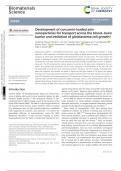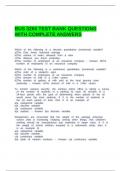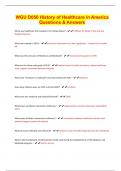Biomaterials
Science
View Article Online
PAPER View Journal
Development of curcumin-loaded zein
This article is licensed under a Creative Commons Attribution 3.0 Unported Licence.
nanoparticles for transport across the blood–brain
Open Access Article. Published on 28 January 2021. Downloaded on 7/26/2021 1:56:24 PM.
Cite this: DOI: 10.1039/d0bm01536a
barrier and inhibition of glioblastoma cell growth†
Huaiying Zhang,a Winant L. van Os,b Xiaobo Tian,c Guangyue Zu,a Laís Ribovski, a
Reinier Bron,a Jeroen Bussmann,d Alexander Kros, b Yong Liua and
Inge S. Zuhorn *a
Glioblastoma (GBM) is a devastating primary brain tumor resistant to conventional therapies. A major
obstacle to GBM treatment is the blood–brain barrier (BBB), or blood–glioma barrier, which prevents the
transport of systemically administered (chemotherapeutic) drugs into the tumor. This study reports the
design of dodecamer peptide (G23)-functionalized polydopamine ( pD)-coated curcumin-loaded zein
nanoparticles (CUR-ZpD-G23 NPs) that efficiently traversed the BBB, and delivered curcumin to glioblas-
toma cells. The NPs enhanced the cellular uptake of curcumin by C6 glioma cells compared to free cur-
cumin, and showed high penetration into 3D tumor spheroids. Functionalization of the NPs with G23
stimulated BBB crossing and tumor spheroid penetration. Moreover, the NPs markedly inhibited prolifer-
ation and migration and induced cell death in liquid and soft agar models of C6 glioma cell growth.
Fluorescence microscopy and flow cytometry studies showed that the CUR-ZpD-G23 NPs increased cel-
Received 10th September 2020, lular ROS production and induced apoptosis of C6 glioma cells. Following in vivo intravenous injection in
Accepted 25th January 2021
zebrafish, ZpD-G23 NPs demonstrated the ability to circulate, which is a first prerequisite for their use in
DOI: 10.1039/d0bm01536a targeted drug delivery. In conclusion, zein-polydopamine-G23 NPs show potential as a drug delivery plat-
rsc.li/biomaterials-science form for therapy of GBM, which requires further validation in in vivo glioblastoma models.
Introduction specific drug delivery into the brain are possible routes for drug
delivery to the brain.5 However, these methods can be difficult
Limited uptake of chemotherapeutic drugs and chemo-resis- to control spatiotemporally, significantly enhance the risk of
tance of glioma cells result in poor treatment options for glio- medical complications and may be problematic for chronic use.
blastoma (GBM) patients.1,2 The inadequate delivery of che- At the BBB the process of selective transcellular transport of
motherapeutics to GBM is largely caused by the presence of the target molecules via carrier-mediated transport, cation-induced
blood–brain barrier (BBB).3 The BBB is a physiological barrier at absorptive transcytosis, or receptor-mediated transcytosis, provide
the vascular-central nervous system interface, which is formed gateways for the delivery of nanoparticles into the brain.6,7
by a continuous layer of tight junction-expressing endothelial Many kinds of nanoparticles (NPs) have recently been
cells, supported by pericytes and astrocytes.4 It restricts the employed to enhance the delivery of existing and novel thera-
paracellular diffusion of macromolecules across the BBB. peutics across the BBB.6,8–10 Among them, biodegradable NPs
Temporary disruption of tight junction integrity to deliver from natural polymers, such as protein-based polymers, have
macromolecules into the brain or intracranial injection for site- attracted remarkable attention as potential drug delivery car-
riers for their low cost and low toxicity.11 Zein, an alcohol-
soluble protein, extracted from corn, has emerged as an ideal
a
Department of Biomedical Engineering, University of Groningen, University Medical drug delivery system because of its excellent biocompatibility
Center Groningen, Groningen, The Netherlands. E-mail: i.zuhorn@umcg.nl
b and biodegradability. Zein has been extensively investigated
Department of Supramolecular and Biomaterials Chemistry, Leiden Institute of
Chemistry, Leiden University, Leiden, The Netherlands for the encapsulation of bioactive compounds (e.g. vitamin D3,
c
Department of Analytical Biochemistry and Interfaculty Mass Spectrometry Center, resveratrol, quercetin and antimicrobials)12–16 because of its
Groningen Research Institute of Pharmacy, University of Groningen, Groningen, The easy self-assembly into NPs, and sustained drug release capa-
Netherlands
d
bility.17 However, zein nanoparticles have poor physical stabi-
Division of BioTherapeutics, Leiden Academic Centre for Drug Research, Leiden
lity at neutral pH or high salinity, and poor redispersibility
University, Leiden, The Netherlands
† Electronic supplementary information (ESI) available. See DOI: 10.1039/ after centrifugation or lyophilization. In addition, weak chemi-
d0bm01536a cal reactivity appears to be a major problem that limits their
This journal is © The Royal Society of Chemistry 2021 Biomater. Sci.
, View Article Online
Paper Biomaterials Science
further applications in the food and pharmaceutical field. Preparation of ZpD NPs, CUR-ZpD NPs and CUR-ZpD-G23 NPs
Recently, it was proposed that surface modification of zein The preparation of curcumin (CUR)-loaded pD-coated zein
NPs with a layer of polydopamine (PDA) enhances their hydro- nanoparticles (CUR-ZpD NPs) was based on a modified
philicity, colloidal stability, biocompatibility and provides a method of phase separation.35 Shortly, zein and CUR were dis-
conjugation site for bioactive functional groups.18,19 Moreover, solved in ethanol (80% v/v) at different weight ratios.
polydopamine ( pD) coating through oxidative self-polymeriz- Subsequently, 1 ml of the mixed solution was rapidly dis-
ation of dopamine at neutral or a weak alkaline condition can persed into 19 mL dopamine hydrochloride solution in Tris-
function as pH-sensitive gatekeeper to control the release of HCl buffer (10 mM, pH 8.5) and stirred for 12 h at room temp-
drug molecules from the NPs in response to a pH-
This article is licensed under a Creative Commons Attribution 3.0 Unported Licence.
erature. Dopamine concentration was fixed at 0.5 mg mL−1
stimulus.20,21 unless specified otherwise. The CUR-ZpD NPs were collected
Open Access Article. Published on 28 January 2021. Downloaded on 7/26/2021 1:56:24 PM.
Curcumin (CUR) is a polyphenol that is widely used in by centrifugation (10 000g for 30 min) and washed with de-
medicine for its pleiotropic anti-inflammatory, antimicrobial ionized water for three times. For the preparation of Z-pD NPs,
and anticancer activities.22–26 However, the use of curcumin is the same procedure was followed without CUR.
greatly hindered by its low bioavailability in both plasma and For G23 functionalization of CUR-ZpD NPs, firstly, G23-cys
tissue because of its poor water solubility, poor absorption, was conjugated to MAL-PEG5K-NH2 in Tris-HCl buffer (10 mM,
rapid metabolism and rapid system elimination.27,28 Here, we pH 7.4) for 3 h via a maleimide–thiol reaction. Subsequently,
developed self-assembled zein nanoparticles as a delivery 2.5 mg ml−1 CUR-ZpD NPs were resuspended in Tris-HCl buffer
vehicle for curcumin. The zein–curcumin NPs were colloidally (10 mM, pH 8), which contained 5 mg mL−1 PEG-G23. After
stabilized by coating with a polydopamine (PDA) layer, which 12 h stirring at room temperature, particles were collected by
also improved their hydrophilicity, and reactivity with nucleo- centrifugation and washed with deionized water.
philic compounds allowing for further modification via
Michael addition or Schiff base reactions. The PDA-coated Characterization of the NPs
zein-curcumin (CUR-ZpD) NPs were functionalized with the
Dynamic laser scattering (DLS) and zeta potential measurements
G23 dodecamer peptide. The ganglioside GM1-binding G23
of blank and CUR-loaded NPs were performed on a commercial
peptide has been shown to mediate BBB crossing of polymer-
laser light scattering instrument (Malvern ZEN3690, Malvern
somes, RNA-binding proteins, and iron oxide
Instruments) at 25 °C and 90° scattering angle. The surface mor-
nanoparticles.29–34 Moreover, effective delivery of BACE1-siRNA
phology of the nanoparticles was observed using a transmission
and doxorubicin to the brain has been reported for G23-func-
electron microscope (Philips CM120) equipped with a 4k CCD
tionalized nanoparticles, resulting in a reduced plaque load
camera at. Carbon film coated 200 mesh copper grids (Electron
and improvement of cognitive function in an Alzheimer’s
Microscopy Sciences) were glow-discharged in air. Fourier
disease model and a reduction in tumor volume in a glioblas-
Transform Infrared Spectroscopy (FTIR) was carried out on a
toma model, respectively.31,32 The CUR-ZpD NPs were opti-
spectrometer (Tensor 27, Bruker, Germany), where the scanning
mized to display a size <100 nm, low PDI, efficient curcumin
range was 400–4000 cm−1, and the resolution was 4 cm−1.
loading and pH-dependent release. The G23-functionalized
PDA-coated zein-curcumin (CUR-ZpD-G23) NPs showed great
Drug loading and release
capacity to cross an in vitro BBB model. Using coumarin-6 as
the fluorescent probe, the NPs showed high cellular uptake by The drug loading (DL) and entrapment efficiency (EE) of curcu-
C6 glioma cells and significant penetration into 3D tumor min were determined by high-performance liquid chromato-
spheroids. In addition, we evaluated the effect of curcumin- graphy (HPLC). The HPLC system (Shimadzu, Kyoto, Japan) was
loaded NPs on the proliferation, apoptosis, migration and cel- equipped with a SIL-20AC autosampler, a LC-20AT pump and a
lular ROS production of C6 glioma cells. SPD-20A absorbance detector. The 50 μL samples were injected
and separated on a Vydac RP-C18 column (250 mm × 4.6 mm i.d.,
5 μm particles, 300 Å pore size, Grace Vydac, Lokeren, Belgium)
with a 20 or 30 min gradient of 2–90% acetonitrile in water/0.1%
Materials and methods formic acid at a flow rate of 1 mL min−1. The levels of curcumin
Materials were quantified by calibration graph and dilution factor. The
Zein protein, curcumin (purity >98%), dopamine hydrochloride encapsulation efficiency (EE, %) and drug loading (DL, %) were
(purity >98%), coumarin-6, 3-(4,5-dimethylthiazol-2-yl)-2,5- calculated based on the following eqn (1) and (2), respectively.
diphenyltetrazolium bromide (MTT), (4-Amidinophenyl)-6-indo-
EE ð%Þ ¼ Weight of CUR in NPs=Total weight of CUR � 100%
lecar-bamidine dihydrochloride (DAPI) and CM-H2DCFDA (5-
(and-6)-chloromethyl-2′,7′-dichlorodihydrofluorescein diacetate) ð1Þ
were purchased from Sigma-Aldrich. G23 peptide with a DL ð%Þ ¼ Weight of CUR in NPs=Total weight of the NPs � 100%
C-terminal cysteine was synthesized by GL Biochem Ltd
ð2Þ
(Shanghai, China) with a purity of 93.6% as analyzed by HPLC
and mass spectrometry. MAL-PEG5000-NH2TFA was purchased To study the drug release, free curcumin and CUR-loaded
from JenKem technology Co., Ltd, (Beijing, China). NPs with an equivalent amount of CUR (500 μg) were placed in
Biomater. Sci. This journal is © The Royal Society of Chemistry 2021






